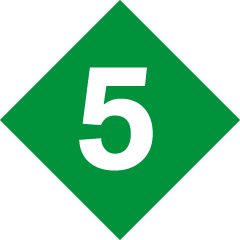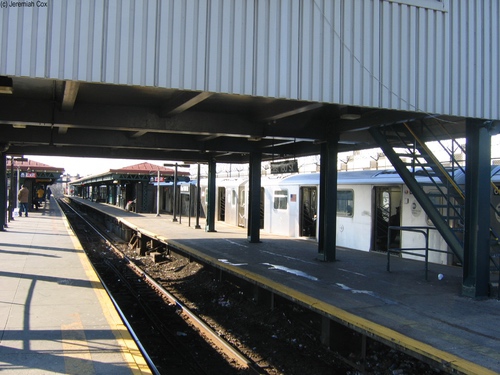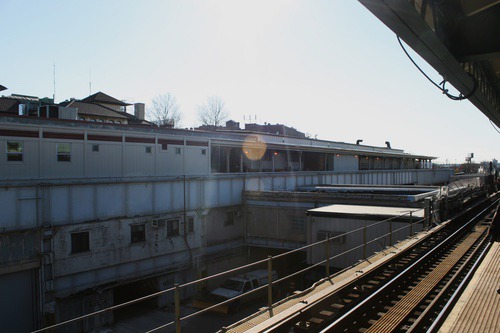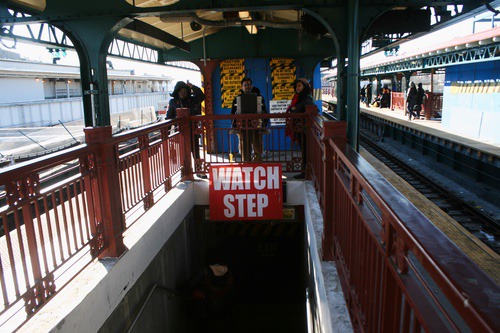













The East 180th Street subway station is a major station transfer point with 2 and 5 trains diverging north of the station. The station is located on an embankment and not an elevated structure. It is also the location of two subway yards, with the East 180th Street yard located directly at the same level of the station, with lots of views from the station platforms. Just north of the station, by the complex interlocking where Dyre Avenue-bound 5 trains leave the White Plains Road Line (every other peak direction rush hour 5 train runs to Nereid Avenue) on a flying junction is the Unionport Yard (which Dyre Avenue-bound 5 trains sometimes operate revenue service directly through). The Dyre Avenue line has better connections with the local tracks and not middle express track, creating some calls over the years to have the 2 train become the rush hour express train and 5 train the local.
The station is an express stop with two island platforms for the 3 track line. The middle track is used by 5 trains during the peak direction rush hour, when all 5 trains run non-stop between here and 3 Avenue-149 Street. These 5 trains run express to Manhattan from 6:00am to 9:00am and to the Bronx from 4:00pm to 8:00pm. These trains open their doors only to the platform in the direction the train is traveling in. Late Night 5 Shuttle trains to and from Dyre Avenue (operating with just 5 cars to allow One-Person Train Operation) also terminate at the station using the middle track and open their doors on both sides to maximize cross-platform connections to and from 2 trains.
Finally, six northbound rush hour trains run express at the end of the AM rush hour from 9:15am to 10:30am and a final, seventh train at 11:30am run northbound express from 3 Avenue-1490 Street to East 180 Street with 4 of the trains terminating at the station and the other 3 continuing up the express track one more stop to Gun Hill Road to terminate before deadheading up to the 239th Street Yard. Several trains before each rush hour also enter service here at East 180th Street.
The station platforms themselves feel typical although the station is built on an earthen embankment and not an elevated structure. Canopies cover the middle-halves of each platform. A crew room building (and a no-public access staircases down to each platform) are located above the northern end of the platforms along with being over the express track. Just beyond the southern end of the canopy is a footbridge with narrow staircases containing No Entry Authorized Personal Only closing off the very narrow staircases that look ladder-like. The platforms contain decorative reproductions of light fixtures (before renovations in 2012, these were generic modern square light fixtures), and decorative structures (that have what look like mini canopies) holding up free standing platform signs). The canopy is the standard green held up by single pillars and a red roof.
To leave the platform there is a single passageway to the station exits, two staircases lead down with an elevator in between from each platform to a mezzanine area. The start of the mezzanine beneath the subway platforms is today bright and airy post the station’s renovations. The walls now have normal white subway tile and mosaic tile for Up Town and Down Town trains. A passageway with stained glass windows and a skylight leads to the station’s only set of turnstiles in an area beneath the now abandoned original New York, Westchester, and Boston East 180 Street Station (see that page for full details). This exit passageway pre-renovations were extremely dark with no windows and the renovation has made it feel light an airy but with an attention to detail for the historical and landmarked New York, Westchester, and Boston Railroad station, still in use as a subway entrance through a station that feels like an Italian villa.
Photos 1: January 25, 2004; 2-7: December 18, 2004; 8-22: January 3, 2011; 23-58: October 13, 2012; 59: April 2, 2013;
Arts For Transit at East 180 Street
Station Villa, 2011, Laminated Glass, Stone, and Glass Mosaic
By Luisa Caldwell


